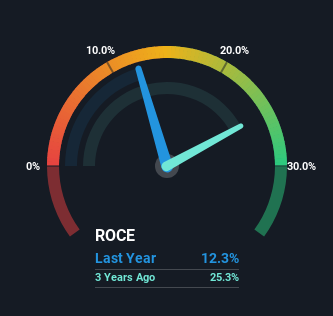- China
- /
- Metals and Mining
- /
- SZSE:001203
Investors Could Be Concerned With Inner Mongolia Dazhong Mining's (SZSE:001203) Returns On Capital
There are a few key trends to look for if we want to identify the next multi-bagger. In a perfect world, we'd like to see a company investing more capital into its business and ideally the returns earned from that capital are also increasing. Ultimately, this demonstrates that it's a business that is reinvesting profits at increasing rates of return. However, after briefly looking over the numbers, we don't think Inner Mongolia Dazhong Mining (SZSE:001203) has the makings of a multi-bagger going forward, but let's have a look at why that may be.
Understanding Return On Capital Employed (ROCE)
Just to clarify if you're unsure, ROCE is a metric for evaluating how much pre-tax income (in percentage terms) a company earns on the capital invested in its business. Analysts use this formula to calculate it for Inner Mongolia Dazhong Mining:
Return on Capital Employed = Earnings Before Interest and Tax (EBIT) ÷ (Total Assets - Current Liabilities)
0.12 = CN¥1.0b ÷ (CN¥13b - CN¥4.3b) (Based on the trailing twelve months to September 2023).
Therefore, Inner Mongolia Dazhong Mining has an ROCE of 12%. In absolute terms, that's a satisfactory return, but compared to the Metals and Mining industry average of 6.4% it's much better.
View our latest analysis for Inner Mongolia Dazhong Mining

Above you can see how the current ROCE for Inner Mongolia Dazhong Mining compares to its prior returns on capital, but there's only so much you can tell from the past. If you'd like, you can check out the forecasts from the analysts covering Inner Mongolia Dazhong Mining for free.
What Can We Tell From Inner Mongolia Dazhong Mining's ROCE Trend?
In terms of Inner Mongolia Dazhong Mining's historical ROCE movements, the trend isn't fantastic. Around four years ago the returns on capital were 23%, but since then they've fallen to 12%. And considering revenue has dropped while employing more capital, we'd be cautious. This could mean that the business is losing its competitive advantage or market share, because while more money is being put into ventures, it's actually producing a lower return - "less bang for their buck" per se.
On a side note, Inner Mongolia Dazhong Mining has done well to pay down its current liabilities to 34% of total assets. That could partly explain why the ROCE has dropped. What's more, this can reduce some aspects of risk to the business because now the company's suppliers or short-term creditors are funding less of its operations. Some would claim this reduces the business' efficiency at generating ROCE since it is now funding more of the operations with its own money.
Our Take On Inner Mongolia Dazhong Mining's ROCE
In summary, we're somewhat concerned by Inner Mongolia Dazhong Mining's diminishing returns on increasing amounts of capital. Investors haven't taken kindly to these developments, since the stock has declined 23% from where it was year ago. That being the case, unless the underlying trends revert to a more positive trajectory, we'd consider looking elsewhere.
If you want to know some of the risks facing Inner Mongolia Dazhong Mining we've found 2 warning signs (1 is concerning!) that you should be aware of before investing here.
While Inner Mongolia Dazhong Mining may not currently earn the highest returns, we've compiled a list of companies that currently earn more than 25% return on equity. Check out this free list here.
New: Manage All Your Stock Portfolios in One Place
We've created the ultimate portfolio companion for stock investors, and it's free.
• Connect an unlimited number of Portfolios and see your total in one currency
• Be alerted to new Warning Signs or Risks via email or mobile
• Track the Fair Value of your stocks
Have feedback on this article? Concerned about the content? Get in touch with us directly. Alternatively, email editorial-team (at) simplywallst.com.
This article by Simply Wall St is general in nature. We provide commentary based on historical data and analyst forecasts only using an unbiased methodology and our articles are not intended to be financial advice. It does not constitute a recommendation to buy or sell any stock, and does not take account of your objectives, or your financial situation. We aim to bring you long-term focused analysis driven by fundamental data. Note that our analysis may not factor in the latest price-sensitive company announcements or qualitative material. Simply Wall St has no position in any stocks mentioned.
About SZSE:001203
High growth potential with imperfect balance sheet.
Market Insights
Community Narratives


Recently Updated Narratives

Astor Enerji will surge with a fair value of $140.43 in the next 3 years

Proximus: The State-Backed Backup Plan with 7% Gross Yield and 15% Currency Upside.


A case for for IMPACT Silver Corp (TSXV:IPT) to reach USD $4.52 (CAD $6.16) in 2026 (23 bagger in 1 year) and USD $5.76 (CAD $7.89) by 2030
Popular Narratives


MicroVision will explode future revenue by 380.37% with a vision towards success


The company that turned a verb into a global necessity and basically runs the modern internet, digital ads, smartphones, maps, and AI.



